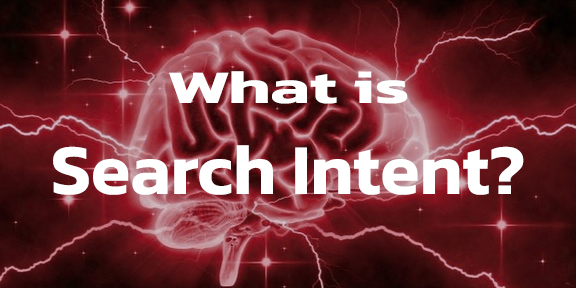When it comes to SEO content marketing, quality traffic is just as important as quantity. In order to drive quality traffic, businesses must pay close attention to search intent.
“ Search intent is the purpose behind an online search or query.”
Creating content around search intent can be a bit complex. With proper research it is possible to identify user intent and strategically create focused content. In this post, we’ll find out how to apply search intent to your business goals.
Table of Contents
The Basics of SEO
To understand why writing for search intent can be so complex, we need to talk about SEO.
The world of search engine optimization (SEO) is a fascinating marriage between creativity and technology. It’s truly both a science and an art. But how?
Think about a commonplace scenario in real life. Someone comes up to you on the street and asks if you “have any change” they could use to catch a bus across town. It’s pretty easy to understand what they’re asking for, right?
Now, imagine typing a similar query into Google. “How to get change” gives you Google results on “where to get quarters” in the search engine results page (SERP).
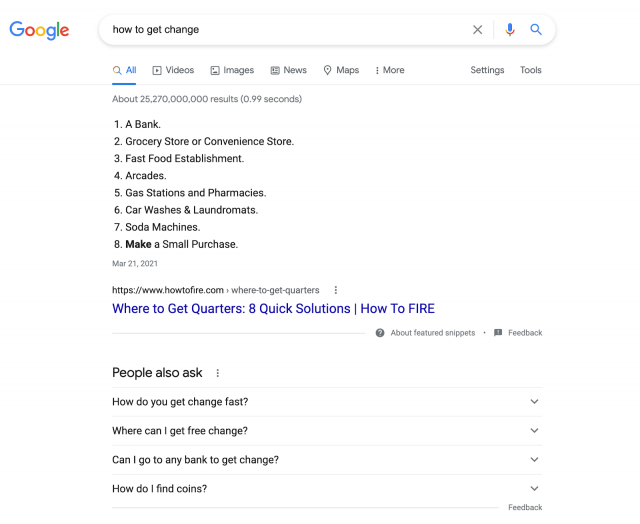
That seems like a pretty accurate result based on what you wanted to know.
However, if you hop over to the Bing search engine and type in the same query, the SERP is totally different. This time, the results are based on how to change as a person, or even how to change the layout in Adobe InDesign. Clearly, the interpretation of your search is very different here.
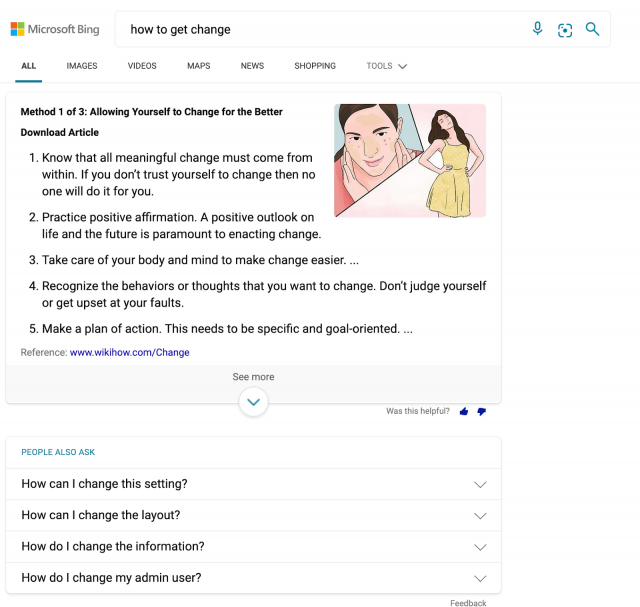
This simple example illustrates the power of a key SEO concept known as “search intent.”
A search engine’s job is using search intent analysis to serve the right results to its users.
Your job is to create content that gives users interesting and correct information.
Understanding the link between a query and content will earn you the best return on your SEO investment.
Now, we’ll break down how to drive quality traffic to your website and get results for your business.
What is Search Intent?
Think about it this way. Every time someone types something into Google, they have a reason for doing so, even if it’s just mild curiosity. The “why” behind a query is the user’s search intent.
In the example we used earlier, the word “change” referred to coins like quarters. A user searching for with the word “change” could also be looking for:
- The definition of the word “change” in the dictionary
- Synonyms for the word “change”
- The mathematical study of change
- The petition website Change.org
- Any number of music albums, songs, or bands called “Change”
For some queries, it’s difficult for a search engine to guess which things the user wants to know. The word “change” is a pretty general term, so without additional words and modifiers in the search query, the search results will vary.
As you start to use longer phrases, which are known as long-tail keywords, it becomes easier to discern the intent behind the query. For example, if you expanded the query for “change” into “change David Bowie,” it’s instantly clearer what you’re looking for.
Always remember, Google exists to put the best results in front of every user for every search query on the SERP. If they can manage search intent optimization most of the time, then people will keep using Google to find what they’re looking for online.
With that in mind, let’s talk more about why understanding search intent is so important for businesses.
What is the Importance of Search Intent?
Search intent matters because it’s the fundamental rule in the SEO game. If your content doesn’t match a user’s intent, then you lose the game. A search engine like Google just isn’t going to rank you anywhere near the top of the SERPs.
Remember, Google is a business too. They are in the business of answering your queries to the best of their ability.
A Win-Win Situation
Search queries are a golden opportunity to pull valuable organic traffic to your website. Matching search intent with content rewards your business, your customers, and search engines. Everyone wins!
As you know, the way SEO works at a fundamental level is to match search intent with content that satisfies a user’s query. Google’s search engine is successful if you
- Type a phrase into the search bar
- Hit enter
- Click on a result
- Find what you were looking for there.
If you optimize for search intent, you’ll be sure to get rewarded. In fact, someone may even backlink to your content which will help you gain even more authority and traffic.
Content Goals
A big goal for any of your SEO content creation efforts should be to understand what users want to know. Next, do the best possible job of answering that query.
But let’s flip the equation around: search intent is also an important consideration for any business looking to create a new piece of content!
As we’re about to see, there must be a balance between
- Content that satisfies user intent
- Focuses on the right search terms
Mastering this balancing act will enhance your conversion rate and take your business to a new level!
The 4 Types of Search Intent
There are four main types of search intent. These can overlap somewhat, but in general, keyword intent will fall into one of the following categories:
1) Navigational Intent
The most basic search term is navigational, often referred to as a “branded keyword.” In a nutshell, a navigational search intent is intended to help users navigate to a specific location online.
Have you ever noticed that you rarely type a URL into the address bar anymore? If you want to get to Facebook you might just pop the word “Facebook” into Google rather than manually typing out www.facebook.com. Your brand will usually be right at the top of search results.
Navigational keywords are also used when you hear about a cool brand on the radio, or your friend recommends this great hairdresser in town. The natural next step is to look for them online.
Ultimately, a navigational keyword helps you find a specific brand, website, or person.
2) Informational Intent
The next type of search intent is informational, also known as informational search intent. A huge chunk of the internet exists for informational intent keywords. In fact, as many as 80% of all search queries are informational.
As the phrase suggests, informational keywords are there to answer questions or inform users about a topic. Here are a few examples of informational keywords:
- How to change a tire
- Old-fashioned apple pie recipe
- How old is John Travolta
Notice how these search terms have nothing to do with making a purchase. Instead, the whole point is just to find out the answer to something. It can be something simple, like fact-checking a piece of trivia, or complicated, like delving into an abstract mathematical concept. The key intent there is for learning, not buying.
This doesn’t mean you shouldn’t create informational content, but understand that informational content is less likely to convert directly into paying customers. However, it does help to inspire confidence and trust between you, search engines, and the customer.
A good place to answer informational searches is via blog articles, like this one!
3) Commercial Intent
If you want to attract users who are ready to buy, you need to write for the third type of search intent.
Commercial intent keywords are the ones that reflect a user who’s looking for information related to a purchase decision. And thankfully, there are many of them.
Here is a quick example of a buyer intent keywords list:
- Best wedding planners in Philadelphia
- Canon vs Sony lenses
- Tuition at Brown University
- Affordable hiking boots
Can you see how these commercial keywords imply that the user is thinking about making a purchase? Just put yourself in their shoes: would they be trying to locate the best service provider for wedding planning just for fun? Or compare different types of camera lenses with no intention of getting one?
It’s possible, but it’s also easy to see how these searches correlate with consumers who want to make a purchase soon.
It’s worth learning as much as you can about commercial keywords because these tend to be the most valuable (and the most competitive).
After all, if you rank for these, you’re likely to have lots of users on your website ready and willing to make a purchase.
4) Transactional Intent
Let’s go one step further. Transactional intent applies to commercial keywords that indicate urgency in making a purchase.
In other words, someone searching for these keywords wants to buy a product or service soon.
These can overlap with commercial intent keywords but typically are phrased to make it even clearer that a purchase is imminent. Here are some common types of transactional intent keywords:
- Branded search terms or product names (such as “Apple” or “iPhone)
- Specific long-tail product categories (such as “17-inch gaming laptops” or “fleece baby blankets”)
- Adjectives like “best,” “cheapest,” or “top”
- ____ “review” phrases (such as “Yamaha P71 review”)
- Words like “discount” or “deal” or “for sale” (such as “Five Guys discount coupon”)
Search intent says a lot about what a user wants, but it also correlates strongly with an essential concept in marketing: the buyer’s journey.
Buyer’s Journey and Search Intent
You may know the buyer’s journey by another name: the buying cycle, the customer journey, or any number of marketing funnel frameworks.
But the bottom line is, most of your customers go through a few important stages before they’re ready to make a purchase:
- Awareness Stage. The buyer realizes they have a problem and may start conducting some research to find out what to do about it.
- Consideration Stage. The buyer has a sense of the problem and now starts looking at different methods or approaches to solve the problem.
- Decision Stage. The buyer decides on a specific service provider, vendor, or product to make their final purchase.
Notice that each of these stages can correlate to the different types of search intent we just talked about.
Awareness Stage – Informational Keywords. For this stage, the user may search for information about their problem. For example, “how to get rid of back pain.”
Consideration Stage – Informational and Commercial Keywords. For this stage, the user may start searching for terms like, “How does chiropractic work?”
Decision Stage – Transactional and Navigational Keywords. For this stage, the user may research or compare specific providers with terms like, “Johnson Chiropractic Reviews.”
As a business, your job is to create content that will rank for each of these important types. If a user finds your website at any stage of the buyer’s journey, then you have a chance to move them along the marketing funnel. The goal is to convert them into paying customers.
This becomes more complex when addressing multilingual markets, where aligning intent with language requires more than direct translation—it’s where SEO translation services help bridge the gap. By considering both linguistic nuance and search behavior, you ensure your content remains relevant and discoverable in every target region.
How to Determine Search Intent
Now, here’s where we put all this search intent “theory” into action.
As a business owner, your goal for search isn’t merely to answer a question someone is curious about, but ultimately to find motivated buyers.
A piece of content is successful for a business when it attracts the type of users who are:
A) ready to make a purchase or
B) interested in finding out more about what your business offers (and hopefully become a customer in the future).
After all, you don’t exist simply to answer people’s questions forever – you’re in business to make money.
It’s similar to how a real-life salesperson will happily answer a few questions that a prospect wants to ask. However, once the prospect shows signs of losing interest, they’ll move on.
Some of your content may exist to demonstrate thought leadership or prove your expertise. More often than not, however, your content should help attract more leads and close more sales.
Using Google Search to Assess Search Intent
Now that you know the importance of search intent, how do you determine search intent for a given keyword?
What you do is type the search term in Google, hit the search button, and scroll down the page of results. Take a look at what Google is already ranking for the keyword you’re looking at. Google has deemed this content important and relevant based on a complex algorithm with a variety of metrics.
Scanning the current results ranking for a search term at the top of Google will tell you what users are trying to find out. If you’re particularly savvy about a subject, you may be able to find gaps that other results didn’t talk about. However, it’s still valuable to see what’s already doing well for any given search term.
This is important because sometimes it’s not the specific information you need to worry about, but the actual format of the content that matters.
If someone types in “calculating a mortgage payment” into Google, they’re likely more interested in finding a mortgage calculator tool rather than a lengthy blog post. They could even be interested in a combination of both.
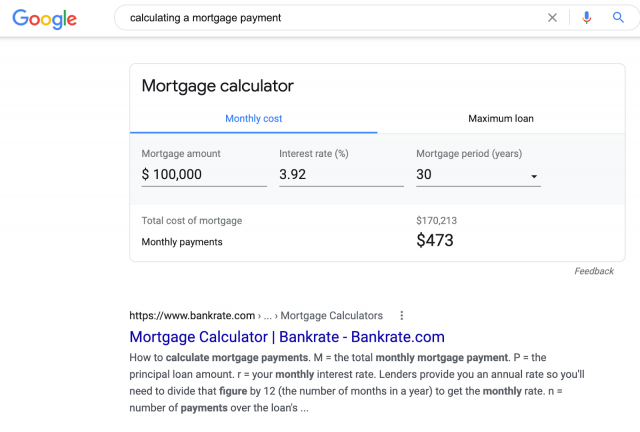
This result on the SERP demonstrates Google’s desire to give searchers exactly what they want and need.
When Google is confident in nailing your search intent, it may even show the result in a snippet as seen below.

This feature offers a very quick answer without requiring you to click through results. Usually well vetted and high authority sites will get their content featured in a snippet.
Checking Google Ads for Intent
Another great way to confirm search intent is by looking at the PPC ads that appear for a particular keyword.
Often, general information keywords won’t have ads, or the ads will be a lot cheaper. You can determine the value of a keyword by how expensive the CPC, or cost per click, is for that keyword.
An SEO tool like Ahrefs can help you quickly gauge the CPC for keywords at a glance, or you can use Google Keyword Planner to find out directly from Google.
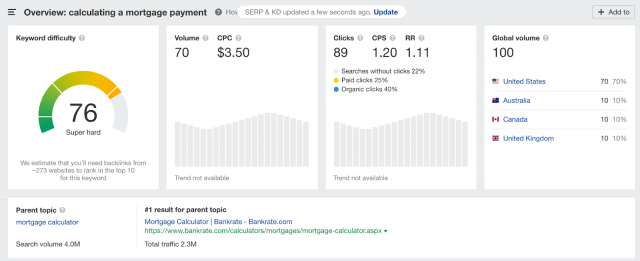
Building a List of Intent-Based Keywords
Ready to build your first list of intent-based keywords? There are two main ways to get started:
- Use a search tool to research your competitors and see what they’re already ranking for. Then, take some time to do keyword intent mapping between these different search terms and important factors. Consider intent and competitiveness to help you prioritize them.
- Think like your customer and brainstorm the types of words and phrases they tend to use. This can be challenging at first, but it’s a great way to find the most relevant keywords to target.
As you start collecting keywords, capture them in a spreadsheet or in a keyword list in your SEO tool of choice. Be sure to add a column for “search intent” and “buyer’s journey stage” to help you understand the type of content you’ll need to produce.
Whichever route you go to build your keyword list, you’ll get more mileage if you actively search Google for the terms you find. We recommend checking out the “People also ask” feature box in the Google search results. It’s usually found a few positions down from the top.

Don’t forget to review the “Related searches” at the very bottom of the results page. Sometimes, the combination of these two areas will give you all you need to know about the search intent for a keyword.

Put it all together and you have a foolproof way to uncover queries with the proper search intent for your business goals!
Final Thoughts
By now you should understand the four main types of search intent. You should also understand the steps you need to take to determine the proper search intent for your businesses’ content marketing.
As we mentioned before, SEO is both an art and a science. When you understand your audience really well, your gut instinct can tell you more than any search tool. Sometimes trusting your human instinct can go a long way.
It’s important to remember that even in competitive niches, there are always exciting opportunities in the world of SEO.
The question is, are you intent on finding them?
Answering search intent is just one of the many parts of SEO to be aware of. If you need help marketing your business online and attracting more targeted and relevant traffic, consider the quality SEO services from Boosted Lab. Our SEO agency can translate your business ideas into reality!

